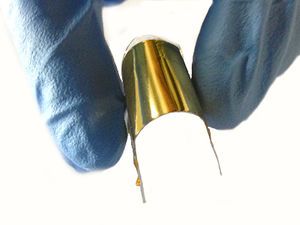There is a long held joke among software programmers called the “ninety-ninety rule.” The joke goes that you spend ninety percent of your time writing ninety percent of your code and then another ninety percent of your time finishing the last ten percent. The joke of course is making light of just how much work there is in finalizing code and how often that gets underestimated. Creating physical products can be the same way, there’s a long walk from having a single prototype in the R&D lab to shipping a finished product. Creating a prototype can be like the first ninety percent of code and that last ten percent is turning the prototype into a product.
When you are building a prototype (in this case, a robot), it gets taken apart and put back together a dozen or more times and each part evolves as you go. Things like cables, brackets, and sensor mounts are cobbled together from spare parts around the workshop and the design continually changes as you hone in on a working prototype. After you have a proof of concept actually working and the team decides that it should become a product you now face manufacturing, which becomes a whole new challenge with very different obstacles to overcome.
Creating a product is always an exercise in attention to detail. You have to count every single part, bracket, wire, nut, and bolt that will be used in a kit and create a full BOM (Bill of Materials) to get started. You also have to figure out the exact assembly steps that your customers will need to follow in order to put their kit together then photograph each step and carefully note all the details. This is where you run into a lot of redesign. Mounting holes need to be moved, a particular bracket costs way too much and has to be produced cheaper, or a sub controller needs to be designed to replace an existing third party product. Often times, figuring out how to manufacture something takes just as much creativity and engineering as building the actual prototype. It can be frustrating and make you want to scream but it can also be a lot of fun. Engineering geeks love to solve problems and when it comes to creating a manufacturable product, they’re seemingly never ending. This is why we sometimes see crowd funded projects fail or take far longer to deliver even after a working prototype has been produced. It’s the age old ghost of the ninety-ninety rule showing up to haunt sleep deprived engineers bent over workbenches at two in the morning.
When we’re turning a prototype into a production ready product we have a pretty go idea of the hurdles we face in order to churn out a few, a hundred or even a thousand. Expensive parts, such as metal brackets, purchased at a premium during the design phase will have to be sourced in high volume in order to keep cost down for production. Interim 3D printed pieces now have to become manufactured, so on and so forth. It’s the things that no one thought of and which weren’t on the list that really get you.
As many of our customers know, most of our kits are built using laser cut acrylic plastic. It is a great material to use since it is easy to manufacture and keeps the cost down on kits which aren't being manufactured in high numbers allowing us to create high end robotics kits with level hobby budgets. A few years ago, we started using tongue and groove designs in a some of our kits. The tongue and groove system is an excellent way to make strong perpendicular joints utilizing our flat laser CNC machine. It worked so well that we continued to roll it out in new kits and used the method in many places. Then, one day, we realized that the parts were not fitting together anymore. We were very perplexed as to why this was happening and started measuring our sheeting. As it turns out the thickness tolerances for cast acrylic sheets can vary up to 1.5 millimeters, which is a huge amount when you are making laser cut parts which are engineered down to 0.1 millimeters. We discovered that parts from one corner of the sheet may work, but parts from another corner of the same sheet might not. Cue an angry call to our distributor about the discrepancies in the sheet thicknesses. The vendor replies that the manufacturer doesn't guarantee any better tolerances and that the variances are normal for cast acrylic sheeting. Part of the problem is that no one else in the world cares about exact thickness in acrylic because it is used for things like making signs where 1.5 millimeter variance just isn't an issue. We, on the other hand, are making robots and robots need accuracy to be built properly.
We never saw this coming because no one ever thought to go into the warehouse with a micrometer and measure 100 sheets of acrylic on all corners. Why would you? We ordered 1/8" sheets and that is what they should be right? Wrong. The plastic sheeting industry plays by different rules and now all the robot kits that use tongue and groove are a problem. There was a lot of hands thrown up in the air that day to say the least. The lesson learned was to not make assumptions about materials and to question the source of every part we use and what the possible tolerances we might run into are. Just because it works in the prototype doesn't mean that it will work for manufacturing. Tolerance variation is worked into every design now. We have since reduced the areas we use tongue and groove in and when we do we are careful about the materials, the groove sizes, and checking that parts fit.
Currently we are working on the first fifty beta units of the HR-OS1 Humanoid and going through the process of sourcing all the parts, finishing electronics design and finalizing the hardware. As we move from prototype to production we have to drill down and look at every little part in order to make the best product possible for the user. This is where something seemingly as simple as the power cable can become a much larger problem, ironic considering we are talking about creating one of the world's most powerful and advanced desktop humanoids.
Here is one of the prototypes. You can see where we have hand soldered and hot glued the power cables onto the CM730 which is the sub controller we used during the prototyping phase. This controller is being replaced by our own Arbotix Pro in the production units.

Here is the robot chassis with our Arbotix Pro in it and a nice clean barrel power jack. Isn’t she pretty!

Here is the standard power cable that we use in our crawlers and other robots. We have had these for years and they work great.

But there's a problem… The straight male barrel plug on the cable is enormous, it sticks out over 3 centimeters. That isn’t good when you are creating a robot kit which is intended to have 3D printed shells mounted to it. Users aren’t going to be very happy with this solution for a power plug. We know that we wouldn’t be.

Luckily, we had already thought of this issue months ago and had planned on changing over to a 90 degree plug. Which shouldn’t be a big deal right? Right?… It turns out that our cable supplier doesn’t have any molds for 90 degree plugs. What follows is a very abbreviated version of the emails that are not uncommon when working with an overseas vendor.
Vendor "We do not have the 90 degree mold and cannot find one. Can you just accept the straight plug? If so we can make the cables this week."
TR "No, we cannot, it won't fit in our kit. There isn’t enough room. We must have a 90 plug."
Vendor "We cannot find a 90 degree plug that works with 18AWG wire. Everyone said no. We found a mold to borrow but it can only work with 24AWG wires. Can you change your wires to 24AWG so we can use this mold?"
TR "We cannot. The robots use a lot of amps and can burn up a wire that small, we must use a thicker gauge wire. What about the vendor I sent you a link to who has the plugs which can do 18AWG wires with 90 degree molds three weeks ago?"
Vendor "We talked to them but they said that we must buy 3,000 units. So we stopped talking to them. No one else can make it. Can you accept the straight plug?"
TR "No, we must have the 90 degree plug. I will talk to the vendor."
(We email the vendor and get a reasonable MOQ to purchase the plugs and send them to our main vendor.)
TR "I have the plugs coming to you with the proper 18AWG wires from the other vendor. Please make the cables ASAP and let us know when you can ship."
Vendor "Okay, we have received the plugs, but there is another issue, the vendor for the switches sent different switches than the last time. Can you accept changes…"
(Matt throws his monitor against the wall)
This is literally only a fourth of the emails that went back and forth for almost two months also including power outages and cables being cut to the wrong lengths among other amusing debacles. This is how sometimes a single small item can hold up the production of very large products. We are happy to say that we think we have solved all the vendor issues the cables should be on their way soon, but fingers are crossed. Here is a sample of what the finished power cables are supposed to be like.

Here is a photo of the 90 degree sample plugged into the Arbotix Pro.

Ahhh, yes, so much better! It takes up far less room and is much easier to cover under 3D printed shells. However, being engineers we looked at all the space on the side of the board where the plug won't stick out of the chassis at all. That would be an even better improvement. If possible we will move the power jack around the corner on the board and have the most optimal design, but we have to balance making last minute changes with decisions about timelines and delivery promises of beta kits. As engineers you always want to keep improving your designs, but sometimes you are forced to put your manager's hat on and make decisions on when to cut off development in order to move into production.

It would be perfect over here! Will it make it into the first run or have to wait for the next revision… stay tuned to find out.






























